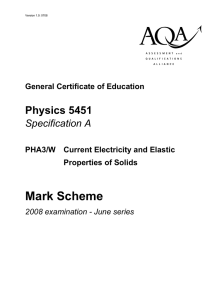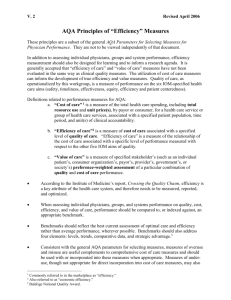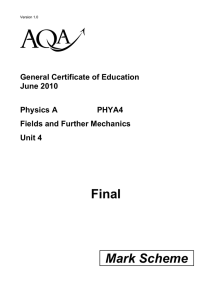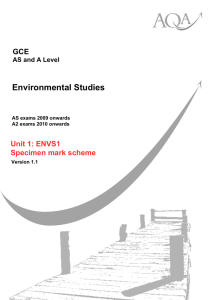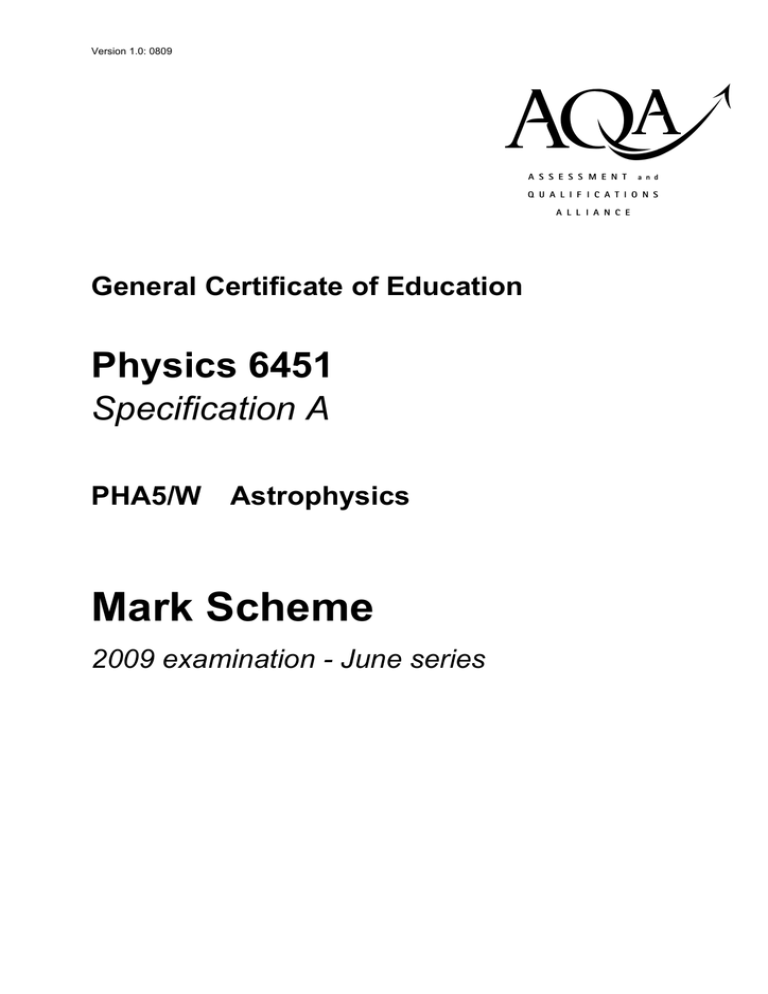
Version 1.0: 0809
abc
General Certificate of Education
Physics 6451
Specification A
PHA5/W
Astrophysics
Mark Scheme
2009 examination - June series
Mark schemes are prepared by the Principal Examiner and considered, together with the
relevant questions, by a panel of subject teachers. This mark scheme includes any
amendments made at the standardisation meeting attended by all examiners and is the scheme
which was used by them in this examination. The standardisation meeting ensures that the
mark scheme covers the candidates’ responses to questions and that every examiner
understands and applies it in the same correct way. As preparation for the standardisation
meeting each examiner analyses a number of candidates’ scripts: alternative answers not
already covered by the mark scheme are discussed at the meeting and legislated for. If, after
this meeting, examiners encounter unusual answers which have not been discussed at the
meeting they are required to refer these to the Principal Examiner.
It must be stressed that a mark scheme is a working document, in many cases further
developed and expanded on the basis of candidates’ reactions to a particular paper.
Assumptions about future mark schemes on the basis of one year’s document should be
avoided; whilst the guiding principles of assessment remain constant, details will change,
depending on the content of a particular examination paper.
Further copies of this Mark Scheme are available to download from the AQA Website: www.aqa.org.uk
Copyright © 2009 AQA and its licensors. All rights reserved.
COPYRIGHT
AQA retains the copyright on all its publications. However, registered centres for AQA are permitted to copy material
from this booklet for their own internal use, with the following important exception: AQA cannot give permission to
centres to photocopy any material that is acknowledged to a third party even for internal use within the centre.
Set and published by the Assessment and Qualifications Alliance.
The Assessment and Qualifications Alliance (AQA) is a company limited by guarantee registered in England and Wales (company number 3644723) and a registered charity (registered charity number 1073334).
Registered address: AQA, Devas Street, Manchester M15 6EX
Dr Michael Cresswell Director General
Physics A PHA5/W - AQA GCE Mark Scheme 2009 June series
Instructions to Examiners
1
Give due credit to alternative treatments which are correct. Give marks for what is correct; do not
deduct marks because the attempt falls short of some ideal answer. Where marks are to be
deducted for particular errors specific instructions are given in the marking scheme.
2
Do not deduct marks for poor written communication. Refer the script to the Awards meeting if
poor presentation forbids a proper assessment. In each paper candidates may be awarded up to
two marks for the Quality of Written Communication in cases of required explanation or
description. Use the following criteria to award marks:
2 marks:
Candidates write legibly with accurate spelling, grammar and punctuation; the
answer containing information that bears some relevance to the question and
being organised clearly and coherently. The vocabulary should be appropriate to
the topic being examined.
1 mark:
Candidates write with reasonably accurate spelling, grammar and punctuation;
the answer containing some information that bears some relevance to the
question and being reasonably well organised. Some of the vocabulary should
be appropriate to the topic being examined.
0 marks:
Candidates who fail to reach the threshold for the award of one mark.
3
An arithmetical error in an answer should be marked AE thus causing the candidate to lose one
mark. The candidate’s incorrect value should be carried through all subsequent calculations for
the question and, if there are no subsequent errors, the candidate can score all remaining marks
(indicated by ticks). These subsequent ticks should be marked CE (consequential error).
4
With regard to incorrect use of significant figures, normally two, three or four significant figures
will be acceptable. Exceptions to this rule occur if the data in the question is given to, for
example, five significant figures as in values of wavelength or frequency in questions dealing with
the Doppler effect, or in atomic data. In these cases up to two further significant figures will be
acceptable. The maximum penalty for an error in significant figures is one mark per paper.
When the penalty is imposed, indicate the error in the script by SF and, in addition, write SF
opposite the mark for that question on the front cover of the paper to obviate imposing the penalty
more than once per paper.
5
No penalties should be imposed for incorrect or omitted units at intermediate stages in a
calculation or which are contained in brackets in the marking scheme. Penalties for unit errors
(incorrect or omitted units) are imposed only at the stage when the final answer to a calculation is
considered. The maximum penalty is one mark per question.
6
All other procedures, including the entering of marks, transferring marks to the front cover and
referrals of scripts (other than those mentioned above) will be clarified at the standardising
meeting of examiners.
3
Physics A PHA5/W - AQA GCE Mark Scheme 2009 June series
GCE Physics, Specification A, PHA5/W, Astrophysics
Question 1
(a)
(i)
2.12 MeV !
(ii)
(0.58 – 0.44) = 0.14 MeV !
(iii)
(if reference is made to electrons/atoms changing energy levels penalise
once and give a maximum mark of 2 – if a nucleus is subsequently referred
to the max will not apply)
•
(following beta decay) nucleus/xenon/daughter may be in an excited
state !
•
excited states of the nucleus/xenon/daughter have
fixed/discrete/definite/particular energies !
•
gamma rays are given off when (the xenon nucleus) drops down
energy levels/de-excites/relaxes/goes to the ground state !
•
the gamma (photon) has a fixed/discrete/definite/particular energy !
•
reference to ΔE = hf ! (give mark for any link between energy and
frequency – it can be very general – no need for a formula)
•
many routes for de-excitation leads to many frequencies
6
any four points !!!!
(b)
electrons are not subject to the strong nuclear force (so it is easy to
interpret the scattering data)
electrons are easy to obtain/accelerate
electrons (can be made to) have wavelengths comparable to the size of
nuclei
2
any two lines !!
(c)
1/3
1/3
(using R = roA or RPb / RSn = (APb / ASn) )
RPb = 5.99 × 10-15 × (208 / 120)1/3
or
2
ro = 5.99 × 10-15/1201/3 !
7.1 " 7.1 × 10-15 m !
(some working with correct numbers must be seen for both marks)
Total
4
10
Physics A PHA5/W - AQA GCE Mark Scheme 2009 June series
Question 2
(a)
(i)
concave primary mirror !
convex secondary !
two correct rays and eyepiece !
3
(b)
(i)
use of θ =
λ
570 × 10 −9
gives θ =
= 1.6 × 10-6 rad !
d
0.356
3
(ii)
the size of the pixels !
(iii)
ratio of the number of photons falling on a device that produce a signal to
the total number of photons falling on the device !
Total
6
Question 3
(a)
(b)
(c)
(i)
Megrez, highest value of apparent magnitude !
(ii)
Alkaid, as it is in spectral class B !
(i)
inherent brightness or brightness seen from 10 pc !
(ii)
Dubhe: it appears the brightest from Earth and it is the furthest away
(therefore it must have the greatest inherent brightness) !
(i)
the distance from which 1AU subtends an angle of 1 second of arc
(ii)
101/3.26 = 31 (parsecs) !
(iii)
use of m – M = 5 log d/10 ! to give
2
2
5
M = 1.9 – 5 log (31/10) !
= – 0.56 !
Total
5
9
Physics A PHA5/W - AQA GCE Mark Scheme 2009 June series
Question 4
(a)
(i)
use of
v=
v
Δλ
= – to give
λ
c
(656.35 − 656.28)
× 3 × 108 !
656.28
= 3.2 × 104 m s-1 !
(ii)
circumference of orbit
4
= orbital speed × orbital period
= 3.2 × 104 × 8 × 24 × 3600 !
= 2.21 × 1010 m (allow ce for 30 k ms-1)
diameter
(b)
= 2.21 × 1010/3.14 = 7.04 × 109 m !
(i)
8 days marked after one cycle !
(ii)
lowest value of apparent magnitude (3.3) occurs when both stars can be
seen !
4
first (smaller) dip occurs when brighter star is in front of dimmer star !
second (larger) dip occurs when dimmer star is in front of brighter star !
Total
8
Question 5
(a)
Neutron star:
any two from:
extremely dense
small (typically 10 km diameter)
max 3
dim
(spinning) radio source
!!
Black hole:
object which has an escape velocity greater than/equal to speed of light !
(b)
use of Rs
= 2GM/c2
= 2(6.67 × 10-11)(40 × 2 × 1030)/(3 × 108)2 !
2
= 1.19 × 105 m !
Total
Quality of Written Communication Q1 (a) and/or Q4 (b) (ii)
6
5
2



